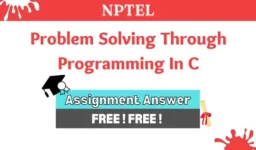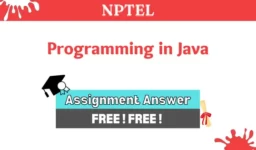
Dear Students, It’s the time to connect with us and improve your marks in the NPTEL week 9th assignment of software testing . Here, in this post, I shall provide you hint of answers to this assignment before the deadline.
NPTEL Software Testing Assignment 9 Answers
Q1. How is overloading different from overriding in object oriented programming?
a. Overloading occurs between two methods in the same class and overriding occurs between methods in a class and one of its descendants.
b. Overloading occurs between a method in a class and one of its descendants and overriding occurs between two methods in the same class.
Answer: a. Overloading occurs between two methods in the same class and overriding occurs between methods in a class and one of its descendants.
1100+ Students helped through Instant Notifications on telegram
Q2. Which of the following represents use of super() keyword?
a. Sub-classes can explicitly use their parents variables and methods using the keyword super().
b. Sub-classes can use their own variables and methods and not the inherited ones using the keyword super()..
Answer: a. Sub-classes can explicitly use their parents variables and methods using the keyword super().
Q3. While applying the mutation operator that deletes a method call, how is the value to be returned by the deleted method passed back to the caller method?
a. The method itself is deleted, so the call should also be deleted in the caller method.
b. The value returned by the deleted method is replaced with a suitable statement in the caller.
c. A message is sent to the caller indicating that there is no value to be returned as the method is deleted.
d. The value returned by the deleted method is replaced with a fixed, constant value.
Answer: d. The value returned by the deleted method is replaced with a fixed, constant value.
Q4. When mutation testing is applied as a black-box testing technique to mutate the inputs, which of the following statements hold true?
a. Both the inputs and the program which is accepting the inputs have to be mutated with one mutation operator.
b. Only the inputs are mutated, the program which is accepting the inputs remains the same.
c. The inputs are not mutated, the program is mutated at a random statement.
d. The inputs are not mutated, the program is mutated at one of the statements that process the inputs.
Answer: b. Only the inputs are mutated, the program which is accepting the inputs remains the same.
Q5. When we change a method call is-divisible(a,b) to is-divisible(b,a) is an example of which of the mutation operators listed below?
a. Integration parameter variable replacement.
b. Integration parameter variable exchange.
Answer: b. Integration parameter variable exchange.
Q6. State yes or no: The programming language Java does not support multiple class inheritance and hence each class only has a single parent.
a. Yes
b. No.
Answer: a. Yes
Q7. Which of the following integration mutation operator represents changing the order of arguments in method invocations to be the same as that of another overloading method, if one exists?
a. Overloading method change.
b. Argument number change.
c. Argument order change.
d. Reference type change.
Answer: c. Argument order change.
Q8. State true or false: While testing inputs using mutation testing, the inputs always have to adhere to their underlying syntax.
a. True
b. False
Answer: a. True
Q9. Towards ensuring that mutation testing subsumes edge coverage, which of the following mutation operators are used?
a. Relational operator replacement.
b. Statement replacement.
c. Logical operator replacement.
d. Condition statement replacement.
Answer: a. Relational operator replacement.
Q10. Which of the statements below are true with reference to mutation testing subsuming all-defs coverage?
a. We need to consider strong mutation to be applied to the statements that contain variable definitions.
b. Both weak and strong mutation on the statements that contain variable definitions will work.
Answer: a. We need to consider strong mutation to be applied to the statements that contain variable definitions.
| TELEGRAM FOR NOTIFICATION | Click Here |
| Follow on Google News (in one click) | Click Here |
Disclaimer: These answers are provided only for the purpose to help students to take references. This website does not claim any surety of 100% correct answers. So, this website urges you to complete your assignment yourself.
Also Available:



Leave a comment